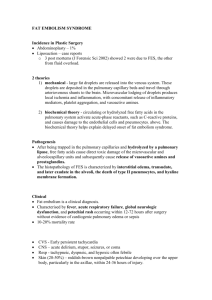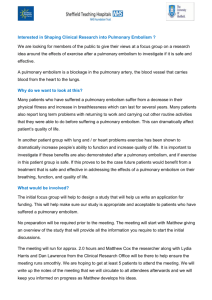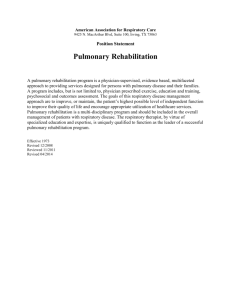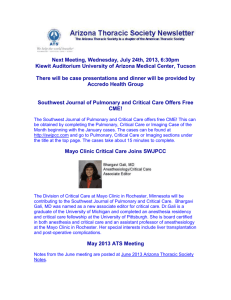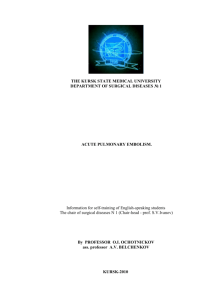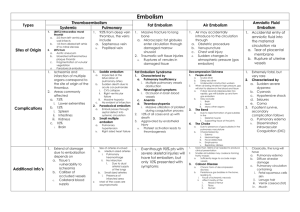Pulmonary Cases
advertisement
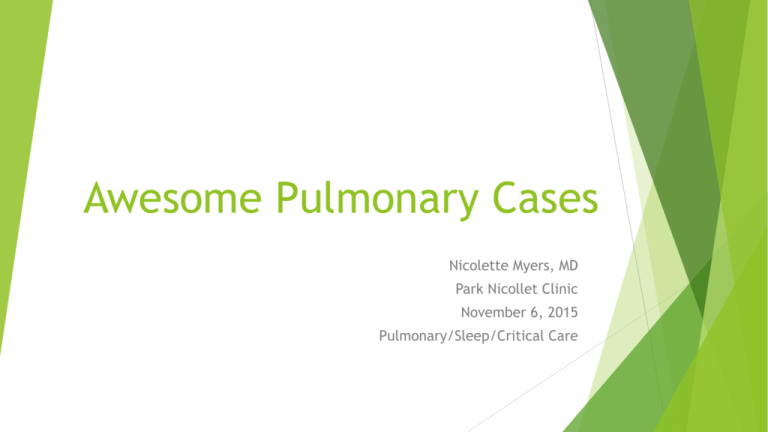
Awesome Pulmonary Cases Nicolette Myers, MD Park Nicollet Clinic November 6, 2015 Pulmonary/Sleep/Critical Care Case #1 History: 43 year old male with no past medical history presents with 2 days of progressive dyspnea and chest tightness. He was moving a piece of furniture up the stairs and noted severe shortness of breath and had to rest half way up the stairs. He denied any leg pain, swelling or discomfort. His symptoms of dyspnea persisted and at the advice of his wife he went to UC for evaluation. He denied fevers, chills or cough but was feeling quite tired. He denied joint pains or skin rash. He typically runs 3 miles 3-4 x per week and lifts weights at the gym. He had traveled by car 2 weeks earlier from Florida. He had no family history of blood clots, early heart disease or sudden death. Case #1 PMHx: Migraines Chews tobacco PSHx Inguinal hernia repair Medications: none Allergies: NKDA Family Hx Father: healthy Mother: arthritis Case #1 EXAM Vitals: HR 130, RR 17, BP: 134/87, Sats 94%, afebrile HEENT: benign CV: tachycardia with right sided third heart sound Lungs: CTA, normal respiratory effort, normal chest excursions Abdomen: soft, NT, ND, no organomegaly Extremities: no swelling, no edema Case #1 Assessment: 43 year old male previously healthy with acute onset dyspnea, tachycardia, mild hypoxia and abnormal cardiac exam. Case #1 Differential Diagnosis Pulmonary PE Spontaneous pneumothorax Pneumonia ILD Cardiac Acute MI Cardiomyopathy SVT or other arrhythmia Tamponade GI Ulcer with chronic blood loss Hematological Acute anemia Case #1 Laboratory Data WBC 6.7K Hgb 16 BNP 100, d-dimer 4.6 troponin 0.22 ECG: tachycardia, no ST elevation, non specific ST wave changes Case #1 Imaging Studies CTA: clot in main pulmonary artery extending into both upper lobe pulmonary arteries and RML and lower lobes, no infiltrates, no adenopathy Doppler ultrasound LE: small clot left popliteal vein Do I need an echocardiogram? Case #1 Echocardiogram Echo cardiogram: mild to moderate RV dilation with decreased RV function, PAP 51mmHg above RAP pressure, LV function normal, clot in PA extending into right PA What do you do next???? Case #1 Treatment Options Anticoagulate Heparin LMWH Thrombolysis IVC Filter Anticoagulate and IVC filter Surgical thrombolectomy IR catheter Massive Pulmonary Embolism (n=1001) Hemodynamics Mortality Stable, RV dilatation 7% Hypotension 14% Hypotension +pressors 23% Hypotension + CPR 60% JACC 1997;30:1165 Pulmonary Embolism Massive PE associated with hypotension, shock and generally large clot burden. Current indication for thrombolytics Hemodynamically unstable PE associated with increased risk of death within first 2 hours of presentation up to 72 hours Submassive: no hypotension but consider thrombolytics High clot burden high RV with evidence of strain pattern on ECG. Persistent hypoxia Free floating clot in atrium PFO Contraindications to Thrombolytics Hemorrhagic or recent stroke (3-6 mo.) Surgery/invasive procedure (<7-14 days) Recent GI hemorrhage (2-6 months) Severe hypertension CNS surgery (3-6 months) Retinopathy Pregnancy/Delivery Bleeding diathesis CPR Thrombolysis vs Heparin in Acute PE Circulation 2004: meta-analysis of all randomized trials comparing thrombolytic therapy with heparin in patients with acute pulmonary embolism. 11 trials, 748 patients, thrombolytic therapy was associated with a nonsignificant reduction in recurrent pulmonary embolism or death Thrombolytic therapy associated with a significant reduction in recurrent pulmonary embolism or death in trials with hemodynamically unstable pulmonary embolism 9.4% versus 19.0% Non major bleeding 22% vs 10% Pulmonary Embolism: Evidence for use of Thrombolytics in Submassive PE NEJM 2014: randomized controlled trial of tenecteplase plus heparin vs heparin alone. 1005 normotensive patients with intermediate risk PE with evidence of RV strain and increased troponin. Hemodynamic decompensation occurred in 2.6% tenecteplase group vs 5.6% in the placebo group P=0.02 No difference in rate of death at 7 days Stroke occurred in 2.4% of tenecteplase group and 0.2% Case #1 Alteplase 100mg IV over 2 hours Patient complained of headache Neuro exam fine, given Tylenol Patient complained of chest heaviness Patient anxious, doctor anxious Clinical exam 2 hours later Headache improved with acetaminophen HR 80, resolution of extra heart sound Case #1, Following Day Subjective: patient feeling much better, no dyspnea or chest discomfort Clinical exam HR 60, BP 111/58, RR 12, sats 96% CV: RRR, nl S1S2 Lungs CTA Echo 24 hours later: mild RV dilation, PAP 22 mmHg above RAP, clot in PA almost completely resolved Assessment and Plan 43 yr old male, submassive PE with mild hemodynamic compromise clinically much improved after thrombolytics. Start rivaroxaban with recommended life long anticoagulation for unprovoked clot Discharge with follow up 3 months CTA and echo Case #2 HPI: 57 year old Caucasian male presents for hematology consult. He had been seen in primary care for routine follow up DM and HTN. At that visit his blood sugars were under fairly good control but he was noted to have polycythemia. Blood work had demonstrated a hemoglobin of 20. One year prior his hemoglobin had been 15. His energy level was low and his breathing was fair. He had chronic lower extremity edema. He denied fevers, chills or chest pains. His weight was up 40 lbs since he quit smoking 1.5 years prior. The patient had smoked 1.5 ppd for 30 years. He did not have a known history of copd. He was unemployed but had worked construction for many years. His wife noted he snored loudly and his sleep was restless. He took a nap every day. He drank 4 cups of coffee per day and at least 2 alcoholic drinks per day. Case #2 PMHx HTN Diabetes type II Psoriasis Seizure disorder Hyperlipidemia Alcohol abuse PSHx Appendectomy Tonsillectomy Hydrocele left side Case #2 Family Hx Mother: HTN, DM Father: atrial fibrillation Medications Metformin 1000mg 2xday Losartan 50mg day ASA 81mg day Atenolol 100mg day Dilantin 300mg day Simvastatin 40mg day Case #2 Exam Vitals: HR 85, RR 18, sats 83% RA, BP 140/90, afebrile, BMI 43 HEENT: ruddy appearing, narrowed posterior pharyngeal inlet, large tongue CV: RRR nlS1S2 Lungs: CTA Abdomen: obese, NT, ND, no organomegaly Extremities: brawny edema bilaterally Case #2 Assessment: Morbidly obese unemployed 57 year old man with new onset polycythemia. Differential Diagnosis: Polycythemia Primary Polycythemia Vera Secondary Pulmonary: Parenchymal : severe ILD or emphysema Vascular: pulmonary HTN, PE, OSA, AVM Toxin: chronic carbon monoxide poisoning Cardiac: intra cardiac shunt: VSD or ASD Renal Cell carcinoma Blood doping Work up Repeat test Cbc : hgb >18.5 men and >16.5 women CXR Urine analysis Carboxyhemoglobin >5% Epo level Consider CT chest and echocardiogram Case #2 Labs WBC 8.4K. Platelets 230K, Hgb 20 U/A negative Epo level 67 (4-27 mU/mL normal) Carbon monoxide level 2.5 (0-5% normal) ABG: 7.4/54/56/33 Case #2 CT: mild to moderate emphysema, no mediastinal adenopathy, no parenchymal infiltrates Transesophageal echo: normal LVF, RV normal, no evidence of shunt, no TR jet unable to calculate pulmonary artery pressure. PFT: moderate obstructive disease, dlco 58%, FVC 75%, FEV1 60%, FEV1/FVC 70 Sleep study Case #2: Sleep Study AHI 47, RDI 62, low desaturations 76%, TCCO2 baseline 62, max 80 Bipap titration 15/6 cm with 3 L/min oxygen Diagnosis Severe OSA with obesity hypoventilation Case #2 Management Patient started on Bilevel with 3L/min oxygen Follow up hgb 17 after 6 weeks of bilevel Follow up hgb 13 after 3 months of bilevel Case #2 Summary Profound weight gain due to smoking cessation: BMI increased from 32 to 43 The distribution of weight gain likely contributed to severity of symptoms. Repeated obstructive events during sleep lead to repeated hypoxic events Suspect component of significant shunt physiology during sleep due to atelectasis at lung bases resulted in marked repeated hypoxic events Underlying emphysema also contributed to hypoxia Secondary polycythemia due to severe hypoxia References Fibrinolysis for patients with intermediate-risk pulmonary embolism. N Engl J Med. 2014 Apr;370(15):1402-11 Management Strategy and prognosis of Pulmonary Embolism Registry. JACC 1997;30:1165 Thrombolysis compared with heparin for the initial treatment of pulmonary embolism: a meta-analysis of the randomized controlled trials. Circulation. 2004 Aug;110(6):744-9 Polycythemia vera and essential thrombocythemia: 2012 update on diagnosis, risk stratification, and management. Am J Hematology. 2012 Mar;87(3):285-93

